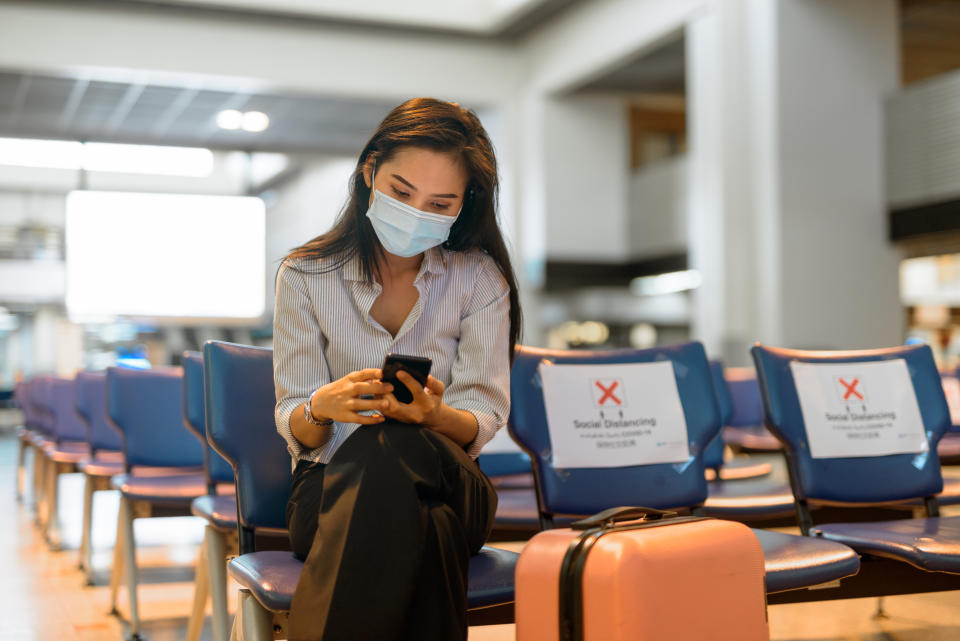Coronavirus spread on flight after asymptomatic passenger used the toilet, study suggests
A woman is thought to have caught the coronavirus from an asymptomatic passenger onboard the same flight.
As lockdown continues to ease, the UK foreign office has relaxed its “essential travel only” advice.
While holidaying in Spain, France or Croatia must be followed by a 14-day quarantine, Britons are free to visit Greece, Italy, Australia and Cuba, to name a few destinations.
Read more: Just 1% of severely ill children died in coronavirus study
According to government guidelines, airlines should “formally advise” customers not to travel if they develop coronavirus symptoms – namely a fever, cough, or loss of taste or smell.
Scientists from Soonchunhyang University in Seoul, however, have revealed a woman is likely to have caught the infection while onboard a flight with a passenger who showed no signs of the coronavirus.
The woman, who was sat three rows behind the infected passenger, is thought to have become infected while using the toilet – the only time she removed her mask.

Toilet ‘most plausible explanation for transmission’
The proportion of asymptomatic patients was debated early in the outbreak.
On 3 March, the World Health Organization’s director-general Dr Tedros Adhanom Ghebreyesus said: “Evidence from China is only 1% of reported cases do not have symptoms and most of those cases develop symptoms within two days”.
Scientists from the University of Hong Kong later claimed 12.1% of patients do not develop a fever.
Read more: Hospital sees heart disease patients drop by 53% during lockdown
When it comes to whether these individuals spread the virus, it has been argued those who do not cough or sneeze – the main routes of transmission – would be expected to transmit the infection to fewer people.
It has been suggested, however, most people who appear to be asymptomatic actually have “really mild disease”.
To better understand the risk of asymptomatic flyers, the Soonchunhyang scientists looked at a 31 March flight from Italy to South Korea.
Of the 310 passengers, six were later confirmed to have flown with an asymptomatic coronavirus infection.
Prior to take-off, the passengers underwent a physical examination, medical interview and temperature check at Milan airport.
Eleven people were not allowed to board after showing symptoms.
In the waiting area, masks were given out and the passengers kept 2m (6.5ft) apart.
Read more: Google anxiety searches break records amid coronavirus pandemic
Once onboard, most of the passengers wore the masks, except when eating or using the toilet.
At the end of the 11-hour flight, the passengers were immediately quarantined for 14 days at a government facility.
On day one of quarantining, six tested positive for the coronavirus, having caught it before flying. On day 14, these patients still showed no signs of the infection and were declared asymptomatic.
Also on day 14, a 28-year-old woman tested positive for the coronavirus.
She reportedly wore a mask while onboard, except when using the toilet, which is known to have also been used by one of the asymptomatic passengers.
The woman sat three rows away from the same asymptomatic individual.
“Given that she did not go outside and had self-quarantined for three weeks alone at her home in Italy before the flight and did not use public transportation to get to the airport, it is highly likely her infection was transmitted in the flight via indirect contact with an asymptomatic patient,” the scientists wrote in the journal Emerging Infectious Diseases.
“She reported coughing, rhinorrhea [a runny nose] and myalgia [muscle pain] on quarantine day eight, and was transferred to a hospital on quarantine day 14.”
The scientists concluded the “most plausible explanation for the transmission of [the coronavirus] to a passenger on the aircraft is she became infected by an asymptomatic but infected passenger while using an onboard toilet”.
It is unclear why the other passengers did not catch the infection.
The aeroplane bathroom may have been contaminated, with research suggesting the coronavirus can survive on surfaces.
Studies also imply the infection may spread via faeces, a lesser route of transmission.
The scientists also looked at 205 passengers doing the same journey on 3 April.
Three were asymptomatic, only testing positive on the first day of quarantine. Another passenger swabbed negative on day one, but positive on day 14.
The scientists “suspect this infection was also transmitted by inflight contact”.
Previous research suggests flu and severe acute respiratory syndrome (Sars) can be transmitted between nearby aeroplane passengers.
This could be a result of the confined space onboard or contaminated surfaces.
Given their results, the scientists stressed the importance of hand hygiene, masks and social distancing when boarding and disembarking planes. This is echoed by the UK government.



